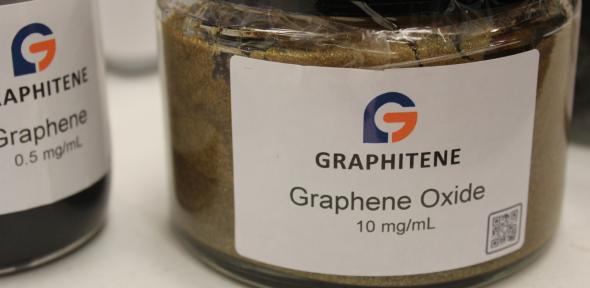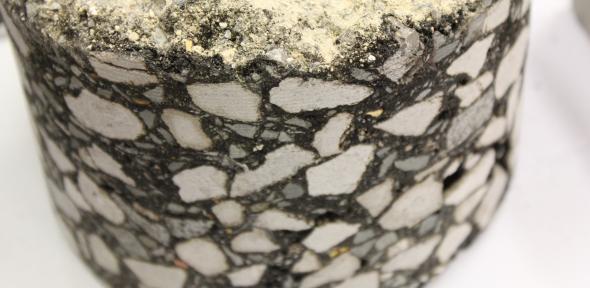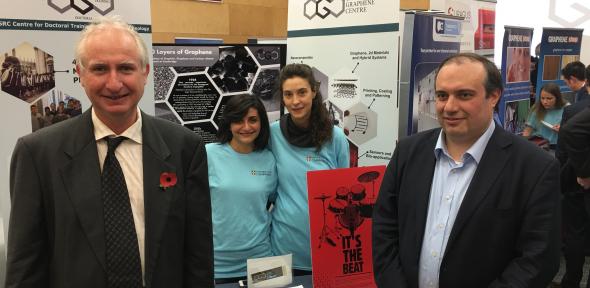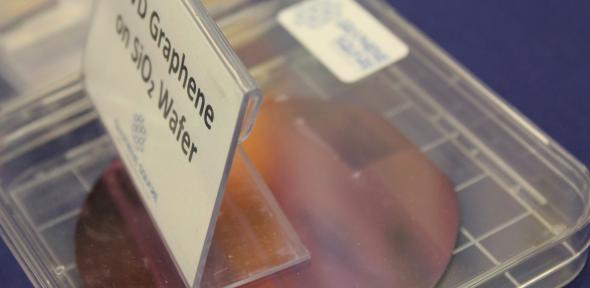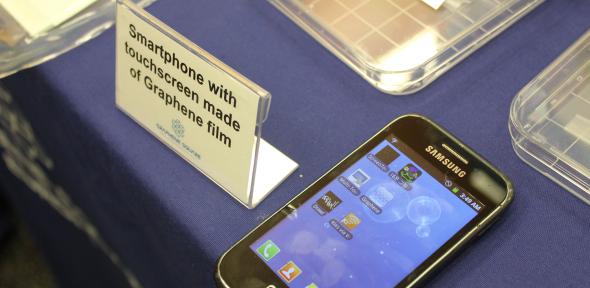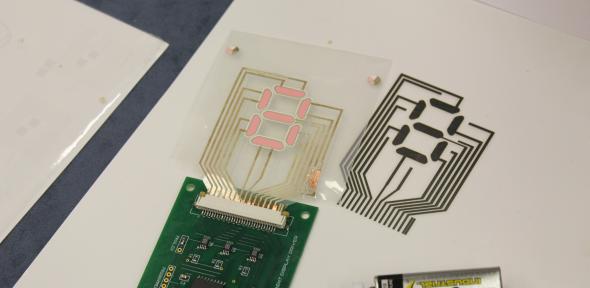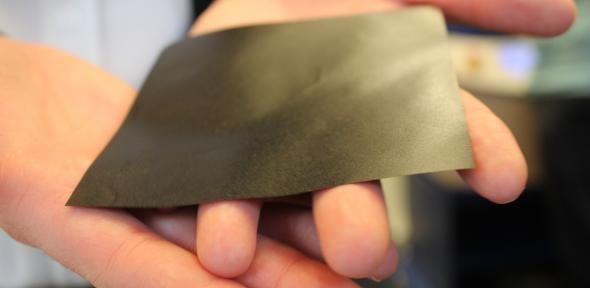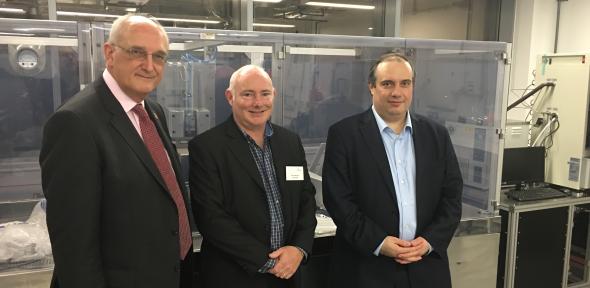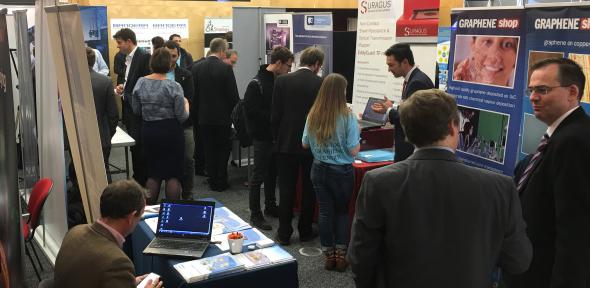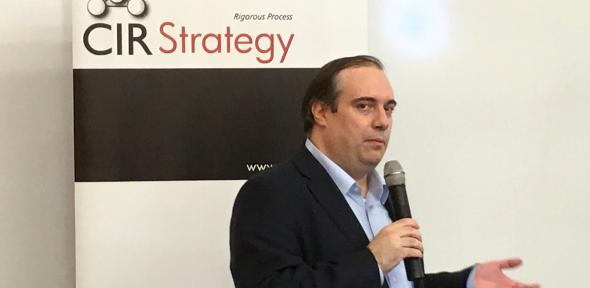A major showcase of companies developing new technologies from graphene and other two-dimensional materials took place this week at the Cambridge Graphene Centre.
A major showcase of companies developing new technologies from graphene and other two-dimensional materials took place this week at the Cambridge Graphene Centre.
Cambridge is very well-placed in the network of UK, European and global initiatives targeting the development of new products and devices based on graphene and related materials
Andrea Ferrari
More than 40 companies, mostly from the UK, are in Cambridge this week to demonstrate some of the new products being developed from graphene and other two-dimensional materials.
Graphene is a two-dimensional material made up of sheets of carbon atoms. With its combination of exceptional electrical, mechanical and thermal properties, graphene has the potential to revolutionise industries ranging from healthcare to electronics.
On Thursday, the Cambridge Graphene Technology Day – an exhibition of graphene-based technologies organised by the Cambridge Graphene Centre, together with its partner companies – took place, showcasing new products based on graphene and related two-dimensional materials.
Some of the examples of the products and prototypes on display included flexible displays, printed electronics, and graphene-based heaters, all of which have potential for consumer applications. Other examples included concrete and road surfacing incorporating graphene, which would mean lighter and stronger infrastructure, and roads that have to be resurfaced far less often, greatly lowering the costs to local governments.
“At the Cambridge Graphene Technology Day we saw several real examples of graphene making its way from the lab to the factory floor – creating jobs and growth for Cambridge and the UK,” said Professor Andrea Ferrari, Director of the Cambridge Graphene Centre and of the EPSRC Centre for Doctoral Training in Graphene Technology. “Cambridge is very well-placed in the network of UK, European and global initiatives targeting the development of new products and devices based on graphene and related materials.”
Cambridge has a long history of research and application into carbon-based materials, since the identification of the graphite structure in 1924, moving through to diamond, diamond-like carbon, conducting polymers, and carbon nanotubes, with a proven track-record in taking carbon research from the lab to the factory floor.
Cambridge is also one of the leading centres in graphene technology. Dr Krzysztof Koziol from the Department of Materials Science & Metallurgy sits on the management board of the EPSRC Centre for Doctoral Training in Graphene Technology. He is developing hybrid electrical wires made from copper and graphene in order to improve the amount of electric current they can carry, functional graphene heaters, anti-corrosion coatings, and graphene inks which can be used to draw printed circuit boards directly onto paper and other surfaces.
Koziol has established a spin-out company, Cambridge Nanosystems, which produces high volume amounts of graphene for industrial applications. The company, co-founded by recent Cambridge graduate Catharina Paulkner, has recently established a partnership with a major auto manufacturer to start developing graphene-based applications for cars.
Other researchers affiliated with the Cambridge Graphene Centre include Professor Clare Grey of the Department of Chemistry, who is part of the Cambridge Graphene Centre Management Board. She is incorporating graphene and related materials into next-generation batteries and has recently demonstrated a breakthrough in Lithium air batteries by exploiting graphene. Professor Mete Atature from the Department of Physics, is one of the supervisors of the Centre for Doctoral Training in Graphene Technology. He uses two-dimensional materials for research in quantum optics, including the possibility of a computer network based on quantum mechanics, which would be far more secure and more powerful than classical computers.
“The Cambridge Graphene Centre is a great addition to the Cambridge technology and academic cluster,” said Chuck Milligan, CEO of FlexEnable, which is developing technology for flexible displays and other electronic components. "We are proud to be a partner of the Centre and support its activities. Graphene and other two dimensional materials are very relevant to flexible electronics for displays and sensors, and we are passionate about taking technology from labs to the factory floor. Our unique manufacturing processes for flexible electronics, together with the exponential growth expected in the flexible display and Internet of Things sensor markets, provide enormous opportunity for this exciting class of materials. It is for this reason that today we placed in the Cambridge Graphene Centre Laboratories a semi-automatic, large area EVG Spray coater. This valuable tool, donated to the University, will be a good match between the area of research of solution processable graphene and Flexenable long term technological vision."
FlexEnable is supporting efforts to scale the graphene technology for use in tomorrow's factories. The company has donated a large area deposition machine to the University, which is used for depositing large amounts of graphene onto various substrates.
“The University is at the heart of the largest, most vibrant technology cluster in Europe,” said Professor Sir Leszek Borysiewicz, the University’s Vice-Chancellor. “Our many partnerships with industry support the continued economic success of the region and the UK more broadly, and the Cambridge Graphene Centre is an important part of that – working with industry to bring these promising materials to market.”
Professor David Cardwell, Head of the Cambridge Engineering Department, indicated the planned development in Cambridge of a scale-up centre, where research will be nurtured towards higher technology readiness levels in collaboration with UK industry. “The Cambridge Graphene Centre is a direct and obvious link to this scale-up initiative, which will offer even more exciting opportunities for industry university collaborations,” he said.
Among the many local companies with an interest in graphene technologies are FlexEnable, the R&D arm of global telecommunications firm Nokia, printed electronics pioneer Novalia, Cambridge Nanosystems, Cambridge Graphene, and Aixtron, which specialises in the large-scale production of graphene powders, inks and films for a variety of applications.
Underpinning this commercial R&D effort in Cambridge and the East of England is public and private investment in the Cambridge Graphene Centre via the Graphene Flagship, part funded by the European Union. The flagship is a pan-European consortium, with a fast-growing number of industrial partners and associate members.

The text in this work is licensed under a Creative Commons Attribution 4.0 International License. For image use please see separate credits above.


